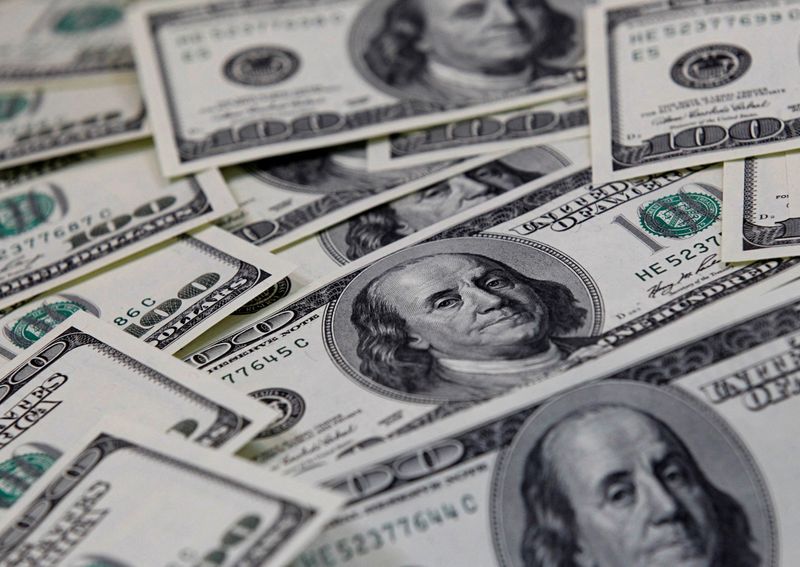Forex
US dollar stumbles, drops to more than one-year low as inflation eases in June


© Reuters. FILE PHOTO: U.S. one hundred dollar notes are seen in this picture illustration taken in Seoul February 7, 2011. REUTERS/Lee Jae-Won/File Photo
By Gertrude Chavez-Dreyfuss
NEW YORK (Reuters) – The dollar crashed to its lowest in more than a year on Wednesday after data showed the rise in U.S. consumer prices moderated in June, suggesting the Federal Reserve may have to raise interest rates only one more time this year.
The dropped to as low as 100.54, the lowest since April 2022, and was last down 1% at 100.55, on track for its largest daily percentage loss since early February.
The greenback also hit its lowest against the Swiss franc since early 2015 after the inflation report. It was last down 1.3% at 0.8675 francs, having fallen to a session low of 0.8660 earlier, its weakest since the Swiss National Bank removed the peg from the Swiss currency in January 2015.
Data showed core U.S. consumer prices rose just 0.2% in June, compared with forecasts for a gain of 0.3%. The monthly rise in core prices was the smallest since August 2021. On an annual basis, U.S. core CPI advanced 4.8%, lower than market expectations for a 5% increase. That was also the smallest annual increase in more than two years.
“Today’s softer core inflation release reinforces our base case and the market’s initial read on the Fed’s last rate decision that the U.S. central bank will only be able to hike one further time this cycle,” wrote Simon Harvey, head of FX analysis at Monex Europe in London, in emailed comments.
The inflation report “resulted in the dollar extending its post-payrolls decline, with losses continuing to be most visible against currencies that are deeply undervalued and sensitive to U.S. yields, such as the Norwegian crown, Swedish crown, and Japanese yen,” he added.
U.S. rate futures still showed traders overwhelmingly expect the policy rate to rise a quarter point, to a 5.25%-5.5% range, at the Fed’s July 25-26 meeting, but now see about a 25% chance of another rate hike before year’s end, down from about 35% before the report.
The euro surged to its highest since March last year of $1.1134. The single European currency last traded up 1.1% at $1.1131.
Jordan Rochester, senior G10 FX strategist at Nomura in London, in a research note said he is raising his conviction on his long euro/dollar trade, targeting $1.14 by end-September. Previously, it was $1.12.
He said bad news for euro area growth has already been priced in, while in the United States, “disinflation pressures…are becoming clearer with core CPI data surprising markets to the downside.”
Against the yen, the dollar dropped to a six-week low of 138.17 yen. It last changed hands at 138.375, down 1.4%.
Sterling struck a fresh 15-month high of $1.30, last trading up 0.4% at $1.2984. The pound’s rally is being driven by expectations for the Bank of England to deliver more rate rises to tame UK inflation, which is the highest of any major economy.
========================================================
Currency bid prices at 2:15PM (1815 GMT)
Description RIC Last U.S. Close Pct Change YTD Pct High Bid Low Bid
Previous Change
Session
Dollar index 100.5500 101.6000 -1.01% -2.841% +101.6100 +100.5400
Euro/Dollar $1.1131 $1.1010 +1.11% +3.89% +$1.1134 +$1.1008
Dollar/Yen 138.3750 140.3800 -1.41% +5.56% +140.3400 +138.1700
Euro/Yen 154.02 154.49 -0.30% +9.78% +154.5200 +153.5200
Dollar/Swiss 0.8675 0.8794 -1.31% -6.14% +0.8793 +0.8660
Sterling/Dollar $1.2984 $1.2931 +0.39% +7.34% +$1.3000 +$1.2905
Dollar/Canadia 1.3184 1.3230 -0.35% -2.69% +1.3234 +1.3144
n
Aussie/Dollar $0.6791 $0.6687 +1.56% -0.37% +$0.6796 +$0.6683
Euro/Swiss 0.9656 0.9679 -0.24% -2.41% +0.9695 +0.9629
Euro/Sterling 0.8571 0.8511 +0.70% -3.06% +0.8575 +0.8506
NZ $0.6302 $0.6198 +1.69% -0.73% +$0.6307 +$0.6183
Dollar/Dollar
Dollar/Norway 10.1130 10.3530 -2.39% +2.98% +10.3490 +10.1050
Euro/Norway 11.2635 11.3868 -1.08% +7.34% +11.4120 +11.2340
Dollar/Sweden 10.3862 10.6608 -1.38% -0.21% +10.6696 +10.3745
Euro/Sweden 11.5622 11.7241 -1.38% +3.70% +11.7573 +11.5473

 Forex3 years ago
Forex3 years agoForex Today: the dollar is gaining strength amid gloomy sentiment at the start of the Fed’s week

 Forex3 years ago
Forex3 years agoUnbiased review of Pocket Option broker

 Forex3 years ago
Forex3 years agoDollar to pound sterling exchange rate today: Pound plummeted to its lowest since 1985

 Forex3 years ago
Forex3 years agoHow is the Australian dollar doing today?

 Cryptocurrency3 years ago
Cryptocurrency3 years agoWhat happened in the crypto market – current events today

 World3 years ago
World3 years agoWhy are modern video games an art form?

 Commodities3 years ago
Commodities3 years agoCopper continues to fall in price on expectations of lower demand in China

 Economy3 years ago
Economy3 years agoCrude oil tankers double in price due to EU anti-Russian sanctions





















